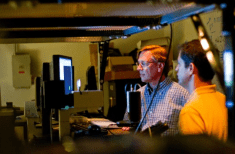Killing Cancer Cells with Acid Reflux
A University of Central Florida chemist has come up with a unique way to kill certain cancer cells – give them acid reflux. 
Chemistry professor Kevin Belfield used a special salt to make cancer cells more acidic – similar to the way greasy foods cause acid reflux in some people. He used a light-activated, acid-generating molecule to make the cells more acidic when exposed to specific wavelengths of light, which in turn kills the bad cells. The surrounding healthy cells stay intact.
The technique is a simple way around a problem that has frustrated researchers for years. For photodynamic therapy (the special laser-light treatment) to work, cancer cells loaded with photosensitizers need oxygen to trigger the fatal reaction. But by their very nature, most cancer cells lack oxygen. Nonetheless, scientists were intent on making the photodynamic system work because it offers a way to target cancer cells deep within human tissue without causing a lot of collateral damage.
Instead of focusing on oxygen, Belfield flipped the problem around and found another way to poison the bad cells, while protecting the healthy ones.
“It’s the first time we’ve found a way around the oxygen problem,” Belfield said. “This work is truly ground breaking. It should eventually provide a therapeutic means to treat certain types of cancers with minimal side effects. It should also be a very useful tool for cell biologists and biomedical researchers. It could even find a place in treating other diseases such as neurodegenerative diseases.”
His work was recently published in the Journal of the American Chemical Society.
Belfield and his team at UCF used human colorectal carcinoma cells for the study, which was funded by the National Science Foundation and the National Institutes for Health. More research is needed to determine that there are no serious side affects in humans and whether the technique will work on a variety of cancers, but Belfield is optimistic.
“Predicting commercialization is difficult at best,” he said. “But we are well situated to forge ahead”.
So how did Belfield come up with such an “outside the box” approach? His other non-medical related research was the inspiration.
Belfield has developed a three-dimensional, optical data-storage system, which involves the use of acid generators. About six years ago he wondered if his approach could have applications in medical therapy.
“It took about five years to get someone in my research group interested to take on the unorthodox project,” Belfield said. “But it seems to have paid off.
Other contributors to the research are Xiling Yue, Ciceron O. Yanez and Sheng Yao, researchers and students at UCF students focusing on chemistry or photonics.
Belfield is one of the pioneers in two-photon absorbing materials, two-photon photochemistry, and two-photon photophysics. His research spans a number of disciplines including organic, polymer, and physical chemistry, as well as optics, optical microscopy, and bioimaging. His research has potential applications in everything from the way people store data on DVDs to fighting cancer.
